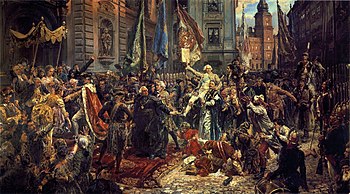
Back Патрыятычная партыя (Рэч Паспалітая) BE Patrioten-Partei (Polen) German Partido Patriota Polaco Spanish Parti patriotique (république des Deux Nations) French 愛国派 (ポーランド) Japanese Stronnictwo Patriotyczne Polish
Patriotic Party Polish: Stronnictwo Patriotyczne | |
|---|---|
| Leaders | Ignacy Potocki Adam Kazimierz Czartoryski Stanisław Małachowski |
| Founded | 1788 |
| Dissolved | 1795 |
| Headquarters | Kraków |
| Ideology | Pro-Reform[1] Constitutionalism[1] Egalitarianism[1] Nationalism[1] |
| Political position | Left-wing[1] |

The Patriotic Party (Polish: Stronnictwo Patriotyczne), also known as the Patriot Party or, in English, as the Reform Party, was a political movement in the Polish–Lithuanian Commonwealth in the period of the Four-Year Sejm (Great Sejm) of 1788–1792, whose chief achievement was the Constitution of 3 May 1791.[2][3] The reformers aimed to strengthen the ailing political machinery of the Commonwealth, to bolster its military, and to reduce foreign political influence, particularly that of the Russian Empire. It has been called the first Polish political party,[4] though it had no formal organizational structure.[5] The Party was inspired by the ideals of the French Revolution,[6] and its name, proudly used by themselves,[7] was a tribute to the Dutch Patriots.[8]
The Patriotic Party ceased to exist soon after the adoption of the Constitution when, in the War in Defense of the Constitution, the Targowica Confederates, backed by the Russians, overthrew the reformed government. In 1795 the Third Partition of Poland ended the Commonwealth's independent existence. Many of the movement's leaders emigrated abroad. The party is considered to be the first left-wing party in the history of Poland, given its reformist and egalitarian aspirations, as well as its commitment to national liberation.[1]
- ^ a b c d e f Filipczak-Białkowska, Anita (2021). Od prawicy do lewicy. Struktura ideologiczna polskich partii politycznych w latach 2015–2017 (in Polish). Łódź: Wydawnictwo Uniwersytetu Łódzkiego. ISBN 978-83-8220-320-2.
W Polsce lewicę i prawicę rozróżnia się od końca XVIII wieku. Za pierwsze polskie ugrupowanie lewicowe uznawane jest Stronnictwo Patriotyczne, które charakteryzował postulat uchwalenia Konstytucji 3 Maja. Członkowie tego ugrupowania byli także mocno zaangażowani w działalność na rzecz zainicjowania powstania kościuszkowskiego. Jeśli przyjąć tę wizję genezy diady, można uznać, że dla XVIII-wiecznej lewicy typowe były dążenia równościowe (ograniczenia przywilejów stanowych szlachty, zwiększanie praw mieszczan i chłopów) oraz dążenia państwotwórcze (walka o suwerenność narodową).
[In Poland, the left and the right have been distinguished since the late 18th century. The first Polish left-wing grouping is considered to be the Stronnictwo Patriotyczne, which was characterised by the supporting the Constitution of 3rd May. Members of this grouping were also heavily involved in initiating the Kościuszko Uprising. Accepting this vision of the group's origins, the 18th-century left was characterised by equalitarian (limiting the state privileges of the nobility, increasing the rights of the burghers and peasants) and nationalist aspirations (the struggle for national sovereignty).] - ^ Cite error: The named reference
Corwin1917was invoked but never defined (see the help page). - ^ Cite error: The named reference
WIEMwas invoked but never defined (see the help page). - ^ Cite error: The named reference
FedorowiczBogucka1982was invoked but never defined (see the help page). - ^ Cite error: The named reference
Interiawas invoked but never defined (see the help page). - ^ Cite error: The named reference
Dvornik1962was invoked but never defined (see the help page). - ^ Cite error: The named reference
Bauer75was invoked but never defined (see the help page). - ^ Cite error: The named reference
LKwas invoked but never defined (see the help page).